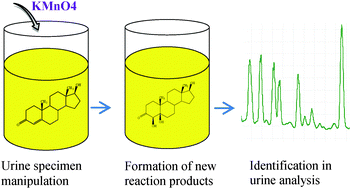Oxidation of testosterone by permanganate and its implication in sports drug testing†
Abstract
Manipulations of urine samples by urine substitution, urine dilution, and urine adulteration with highly oxidative chemicals to escape detection in doping control analysis have been reported in the past. Adulteration of urine with oxidising chemicals such as potassium permanganate, cerium ammonium nitrate, pyridinium chlorochromate etc. can lead to considerable changes in the endogenous steroidal profile parameters and thus mask the abnormality in the steroidal profile following steroid abuse. In this study we have identified the formation of two stable oxidation products upon reaction of potassium permanganate with testosterone, an important endogenous urinary steroid. Isolation and characterisation of these oxidation products were performed using chromatography and spectroscopy and the products were elucidated as 4α,5α-dihydroxytestosterone and 4β,5β-dihydroxytestosterone. Formation of these two molecules in human urine after adulteration with potassium permanganate has been demonstrated by liquid chromatography-mass spectrometry (LC-MS) analysis. The products 4α,5α-dihydroxytestosterone and 4β,5β-dihydroxytestosterone have not been previously reported in urine and hence have the potential to be included in the routine drug testing program for monitoring possible testosterone abuse and permanganate adulteration of urine.


 Please wait while we load your content...
Please wait while we load your content...